“The Crown Jewels of Iran” are by far the largest, most dazzling and valuable jewel collection in the world. The collection housed at The Treasury of National Jewels, situated inside the Central Bank of Iran, backs the Iranian national currency as a reserve. The majority of the items were acquired by the Safavid dynasty, which ruled Iran from 1502 to 1736 AD. These jewels were last used by the Pahlavi dynasty’s, Mohammad Reza Pahlavi and his Shahbanu, Farah Pahlavi, during official ceremonies and state visits.
Compilation of the Coronation Ceremony.
Credit: Defrojgil Kathiresan
The jewels were kept far from public view in the vaults of the Imperial treasury for many years, due to their great value and economic significance, after the first Pahlavi Shah had transferred ownership of the crown jewels to the state. It was then, Mohammad Reza Pahlavi ordered that the jewels should be put on public display at the Central Bank of Iran.
I will take you through a virtual tour of some these exclusive jewels in my new series.
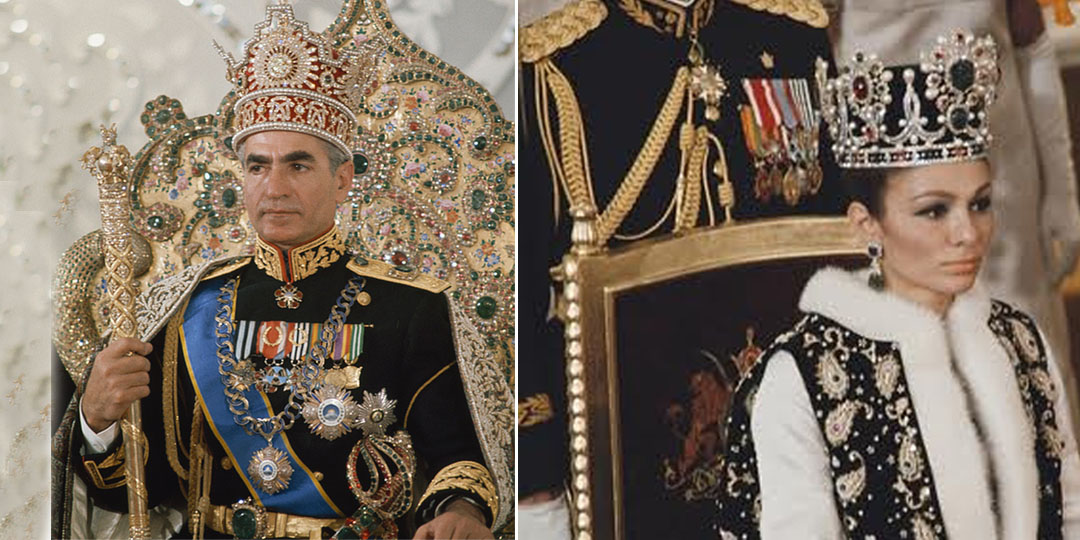
The Pahlavi Crown:
This crown was used in the coronation of Reza Pahlavi and the coronation of Mohammad Reza Pahlavi. Upon its ascension to the throne in 1925, the Pahlavi dynasty commissioned best Iranian jewellers under the supervision of Haj Serajeddin Javaheri, to design and create a new crown; to replace it with the one used by the outgoing Qajar dynasty.
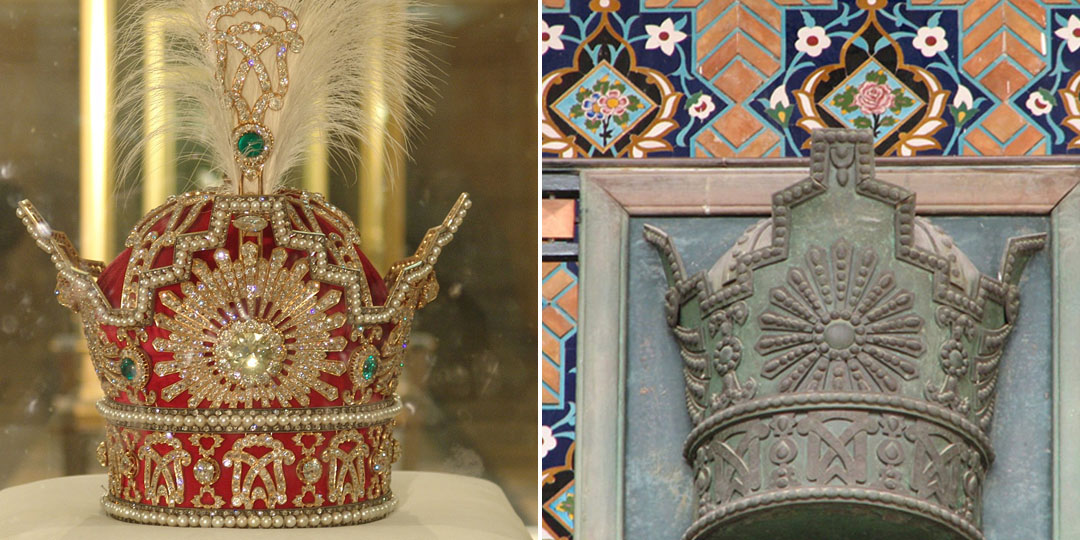
The art and historical references of the Sasanian Empire which ruled Persia from 224 to 651 AD, was taken as an inspiration to design the crown. It’s made of gold and silver and embellished with diamonds, emeralds, sapphires and pearls on a red velvet fabric. The 4 sides of the crown has battlement designs and sunbursts on the four panels, set in diamonds, the front sun design is studded with 60cts of the large yellow diamond. The crown is embellished with 1,144cts of Diamonds; 5 pieces of Emeralds; 2 pieces of Sapphires along with 368 perfectly matched Pearls.
The Naderi Throne (Takht-e Naderi):
The Naderi Throne of Iran is a gemmed and enamelled throne made during the Qajar era, by the order of Fath Ali Shah Qajar (1772–1834). The throne has no relation to Nader Shah: the name derives from the word Nader meaning ” Rare and Unique” in the Persian language.
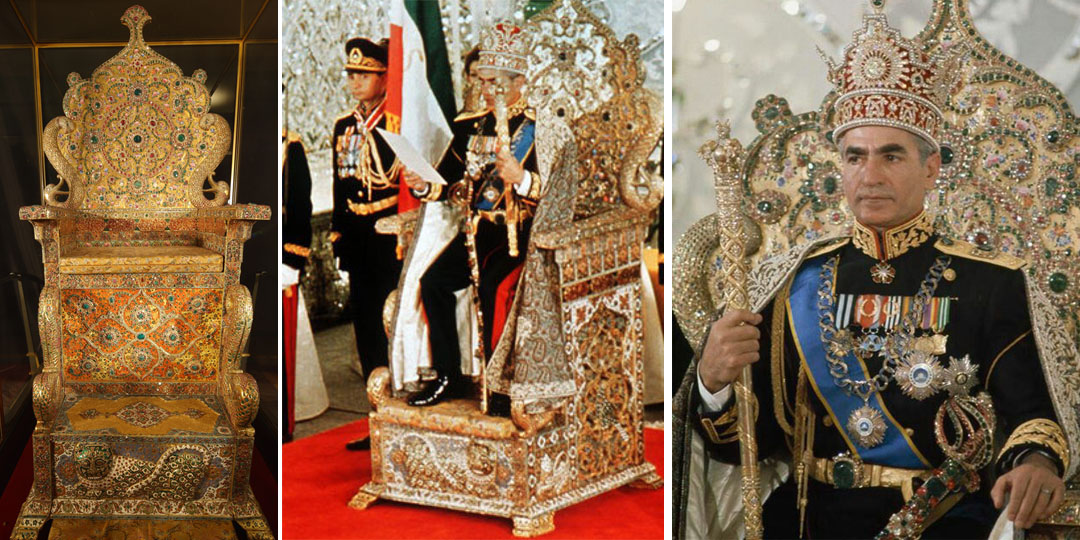
Speaking of the design of the throne; Naderi Throne has the appearance of a chair, which can be taken apart into 12 separate sections. It was intended to be portable, to be carried along with Shah. It’s made of wood, covered with gold and encrusted with jewels. Among the 26,733 jewels covering the throne, there are four very large spinels on the backrest, the largest of them weighing 65 ct. There are also four very large emeralds on the backrest, the largest of them weighing approximately 225 ct. The largest ruby on the throne is 35 ct. The designs which can be seen on the throne include a peacock tail on the backrest, ducks, dragons, leaves and tree branches. A lion rests on the front panel of the footstool.
The Peacock Throne (Takht-e Tavoos):
The “Peacock Throne”, also known as the Sun Throne due to the design of the sun encrusted with precious stones at the top.
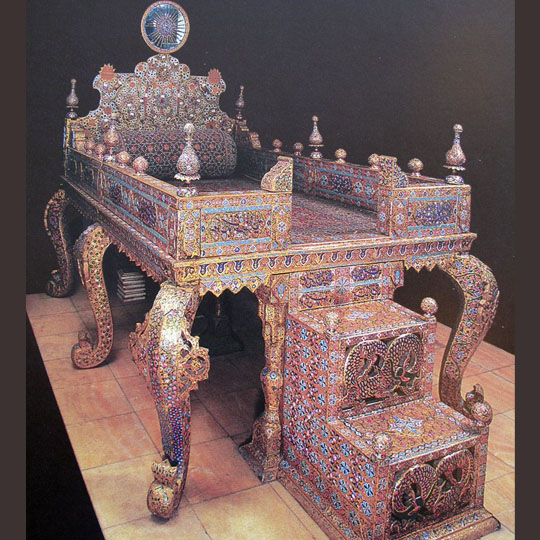
This throne was made by the order of Fath-Ali Shah Qajar. When Tavous Tajodoleh became the queen, due to her name, the throne became popular as Takht-e Tavous or the Peacock Throne, because of her first name, Tavous.
The Imperial Sword of Iran:
The role of a SWORD, in every Emperor’s journey, is very important. Amongst the many magnificent jewels is “Imperial sword” or “Shahi Sword”, manufactured in1306 AH.

The whole handle, hilt and scabbard of the sword was encrusted with around 3000 stones, including large emeralds, rubies, diamonds and spinels. The sword measures 103 cm. Reza Shah hung the sword on the Emerald belt. The three curved rods that form the toggle of the sword, each ending in the head of a diamond snake, have eyes with rubies. The back of the pod is with gold.
Shah’s Coronation Belt:
Among the unique jewels worn by the Shah of Iran on his coronation was a spectacular “Golden Belt or Shah’s Coronation Belt” created at the command of Naser al-Din Shah Qajar; It was used in the coronation of Reza Khan Pahlavi in 1926 AD and reused for the coronation of Mohammad Reza Pahlavi. The belt is made with a unique 176cts heart-shaped cabochon cut Emerald, embellished with brilliant-cut and Rose cut diamonds, with an adjustable clasp.

Taj-e Kiani (The Kiani Crown):
The Kiani Crown was the traditional coronation crown, built during the reign of Fath Ali Shah; used during the Qajar dynasty (1796–1925) as the Iranian Crown Jewels.
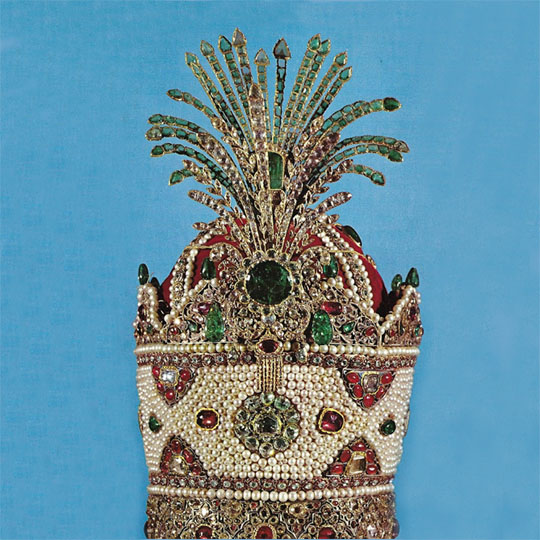
The crown is made of, red velvet; set with 1800 small pearls, along with 300 emeralds and 1,800 rubies, representing the colours of the flag of Iran. Aigrette and knurls decorated with various stones enhance the beauty of the crown. The crown’s height reaches 32 cm and is 19.5 cm.
Koreh-e-Javaherneshan:
The Globe of Jewels was made by a group of Iranian craftsmen, under the supervision of Ebrahim Massihi, in 1869 AD, as ordered by Nasser-ed-din Shah, using the loose stones of the Treasury.

The net gold used in the Globe is 34kg, embellished with 51,366 pieces of gems. The oceans and seas are identified in emeralds and lands are shown in rubies. Southeast Asia, Iran, England and France are specified with diamonds. India is shown in pale rubies. Central and South Africa are shown in sapphires. The equator, as well as other geographical lines, is in diamonds and rubies. The diameter of the Globe is about 66 centimetres. The stand is of gold and studded with gems.
Crown of Empress Farah:
The crown was a part of the coronation regalia used by Shahbanu (Empress) of Iran, Farah Pahlavi.

With the vision to grant freedom to the Iranian women, Mohammad Reza Shah decided to hold a ceremony to crown Queen Farah. With this, he marked it as a very symbolic effort ever in the history of Iran. Empress Farah wore 15 meters long dark-emerald green velvet coronation cape. The upper part is studded with diamonds, rubies, emeralds and pearls; making up a beautiful pattern of Persian paisley.

Van Cleef Arpels made the crown, using precious gems from the Royal Treasury. The crown is crafted with a 92cts emerald in the centre along with 36 Emeralds, 105 Pearls, 34 Rubies, 2 Spinels, and 1,469 diamonds set in a white gold frame over a green velvet cap.
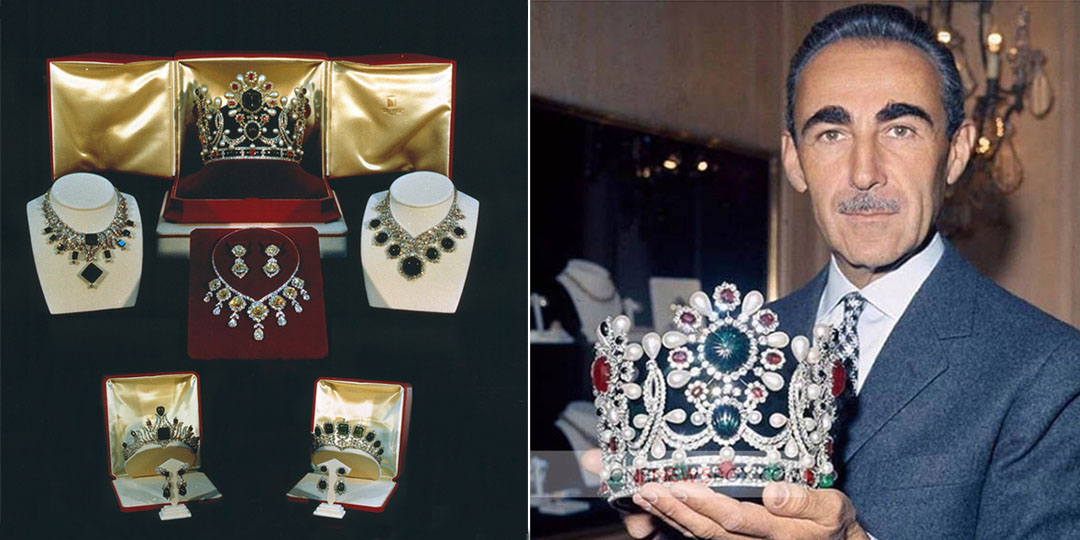
The story goes, out of the fifty proposals for the design of the Imperial crown submitted by the greatest jewellers of the time, the Iranian government had chosen the design by Pierre Arpels. According to Iranian tradition, the crown had to be crafted with jewels from the National Treasury located in the Central Bank of Iran. Unable to bring the priceless jewels back to Paris, Pierre Arpels spent days in the Central Bank’s basement passionately selecting each stone that would adorn the Imperial Crown with the help of his designer. A complete workshop was set in the National Treasury room to achieve this special order!
Empress Farah’s Necklace and Earrings.
Queen Farah’s coronation jewellery, crafted by Van Cleef Arpels with great finishing to detailing and gemstones from the National Treasury.
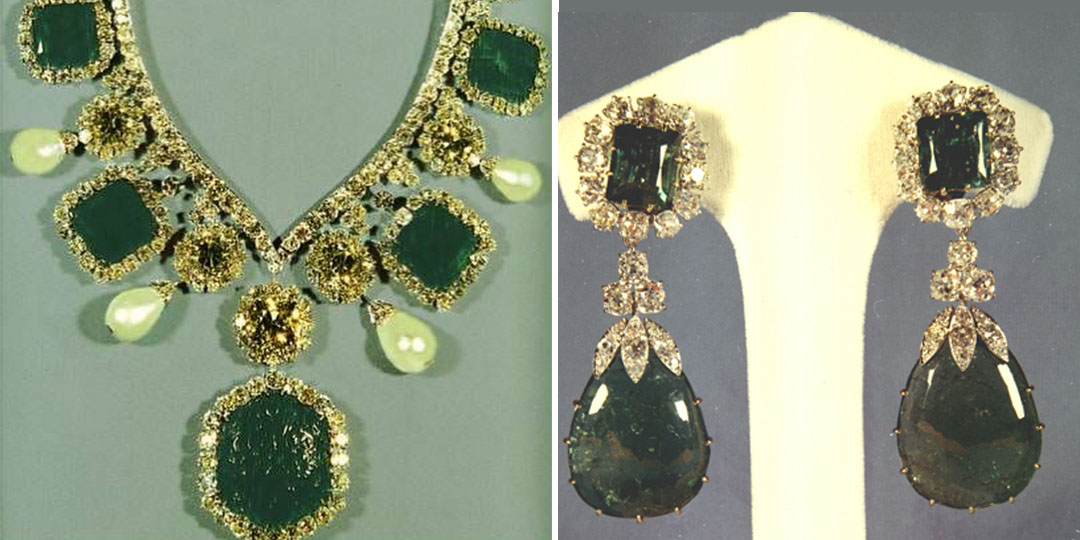
Featured above is a platinum necklace and earrings set for Empress Farah. The necklace includes a large carved hexagonal Emerald pendant and 9 other emeralds, 11 yellow diamonds, and 4 pear-shaped pearls. Empress Farah wore a pair of coordinating earrings by Van Cleef during the coronation.
Sunburst Tiara:
Princess Fatimeh of Iran, the half-sister of Mohammad Reza Pahlavi wore the Sunburst Tiara for her brother’s coronation crafted by Van Cleef Arpels.
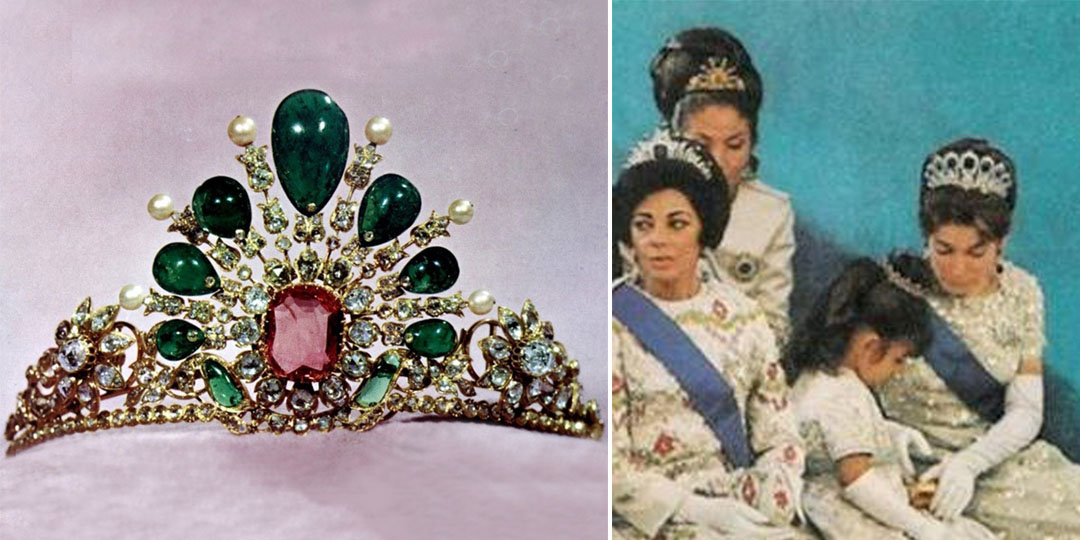
The most attractive feature of the tiara is its 25-carat cushion-shaped Pink Spinel, It is surrounded by a row of diamonds, where each diamond forms a base for the rays depicting the sunburst arise. There are eight emeralds on both sides of the tiara with the ninth emerald weighing 20cts in the middle. There are two identical floral motifs on the ends of the tiara, with a single large diamond in the centre. The base of the tiara is covered by a row of diamonds.
Emerald Flame Necklace, Earrings, Diadem:
Van Cleef Arpels created an Emerald Flame Necklace, Ear clips and a diadem for Princess Shams, elder sister of Mohammad Reza Pahlavi.
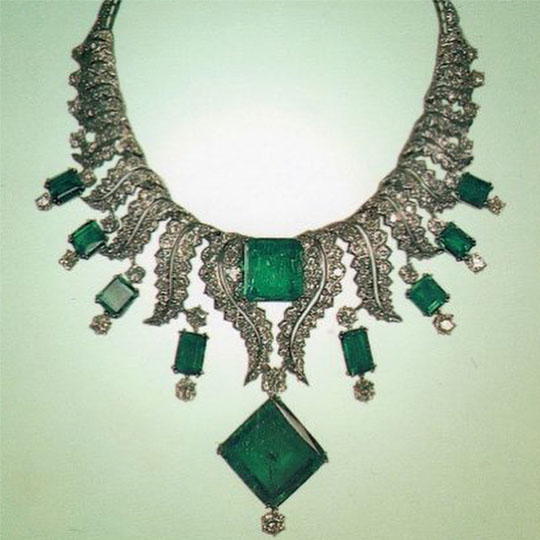
The base of the necklace resembles an inverted version of the tiara with rays resembling flames. A large square-cut emerald nests in the very top of the base with small rectangular emeralds, each topped by a round diamond, suspended from the sides. From the cluster of the square diamond hangs a large rhombus-shaped emerald, also topped by a round diamond. The tiara of the parure consists of flame design. The central cluster is topped with a large pear-shaped emerald, with three smaller square-cut emeralds on either side of it.
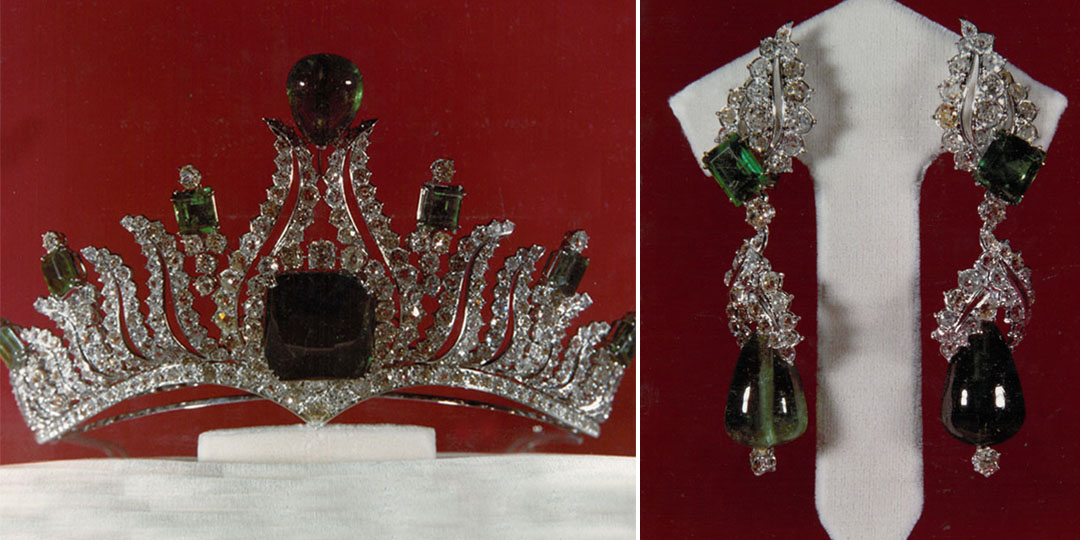
Emerald and Diamond Parure for Princess Shahnaz:
Princess Shahnaz of Iran is the first child of the Shah of Iran, Mohammad Reza Pahlavi, and his first wife, Princess Fawzia Fuad of Egypt.
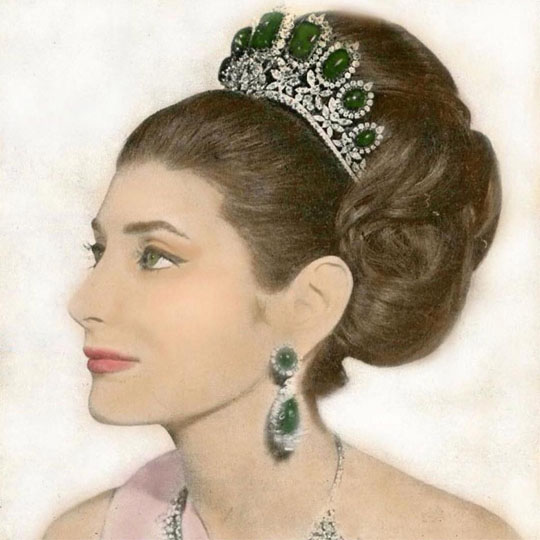
Van Cleef Arpels crafted a gorgeous Emerald and Diamond parure for the princess to be worn at the coronation.

The tiara is set with a diamond base, topped by 9 large cabochon-cut emeralds and the necklace has a similar design, with 7 emeralds. The earrings are also crafted in cabochon-cut emeralds.
Empress Farah Pahlavi’s demi-parure:
Beautiful demi-parure was created by Van Cleef Arpels which the empress wore on the evening of the coronation ceremony. The outstanding necklace consists of seven square Yellow Diamonds surrounded by old-cut diamonds along with seven pear-shaped diamonds.
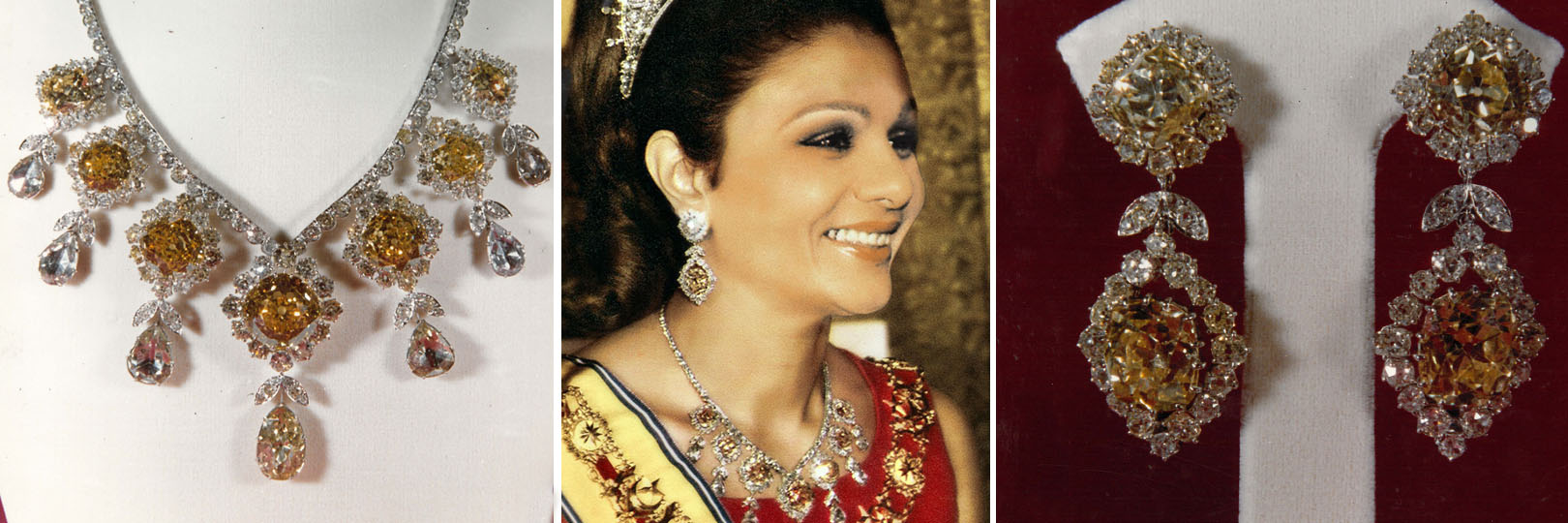
Seven Emerald Tiara:
This unique emerald tiara was made by Harry Winston in 1958 in advance of the marriage of the Shah of Iran and Farah Diba. This tiara is said to have been Empress Farah’s favourite, she wore it for many important events and posed for multiple photographs with the tiara, pairing it with different jewels.
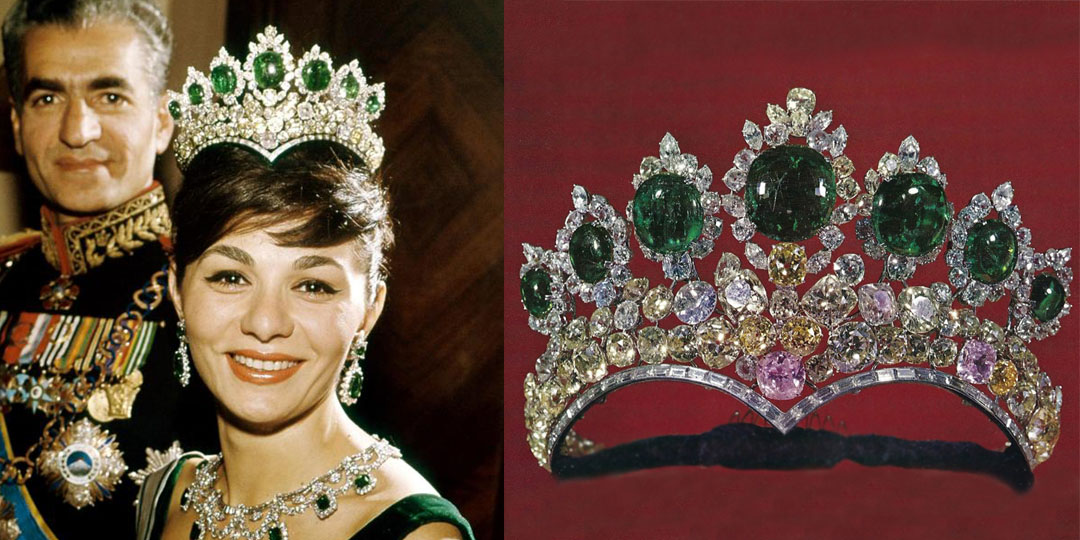
It includes a mix of colour diamonds and incorporates stones from the Iranian crown collection. The heart-shape pointed base is made of a row of platinum-set baguette white diamonds sitting underneath a double row of Pink, Yellow, and White diamonds. The brilliants are thought to be from the 19th century and Indian origin; with 2 large 15 carats pieces. The top of the tiara is set with seven large oval and round cabochon emeralds, ranging in size from 10 cts to 65 cts. Like most of the rest of the imperial jewels, this tiara was left behind in Iran when the family left following the revolution of 1979. The jewels are state property and displayed in Treasury of National Jewels, located in the Central Bank in Tehran.
Turquoise Jewels:
Iran has been an important source of turquoise for at least 2,000 years. It was initially named by Iranians “pērōzah” meaning “Victory”, and later the Arabs called it “fayrūzah”, which is pronounced in Modern Persian as “fīrūzeh”. In Iranian architecture, the blue turquoise was used to cover the domes of palaces because its intense blue colour was also a symbol of heaven on earth.
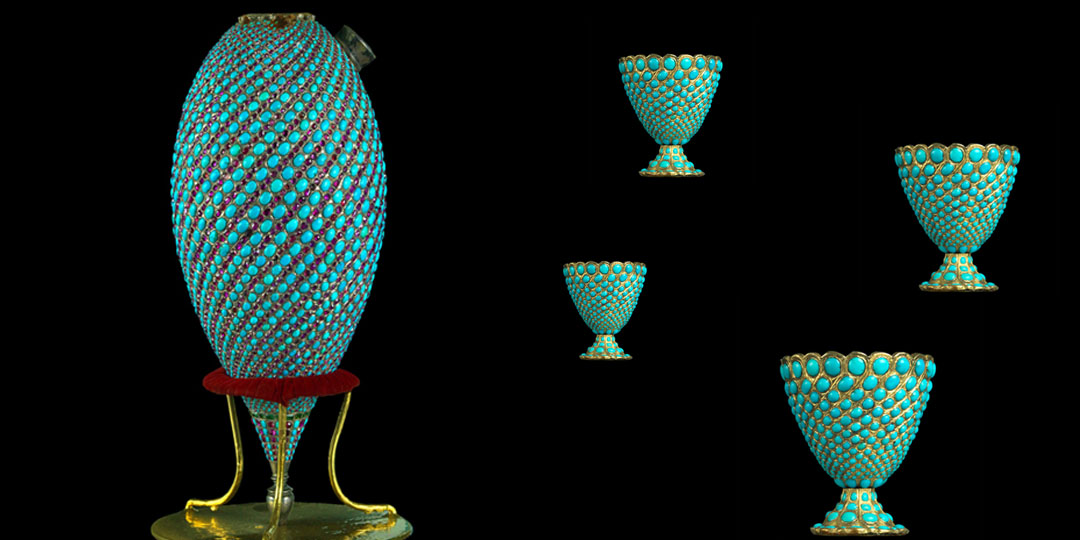
Featured above are the most exclusive jewels made in Turquoise. Water pipe with spiralling rows of turquoise and ruby graduated in size. Nasirud-Din Shah, 1848–1896, and Turquoise coffee cup, made in the reign Nasirud-Din Shah Qajar, 1831 – 1896.
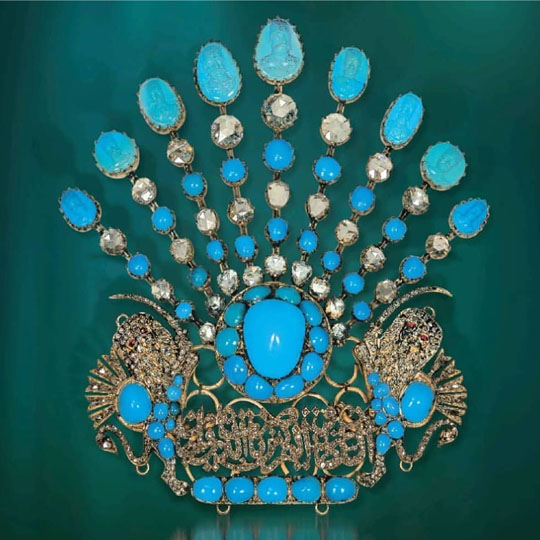
Throughout the centuries, the intense sky-blue Iranian turquoise, known as “Persian Turquoise,” has been the most sought after. They come from mines located in Iran, which produce brilliant sky blue turquoise with little to no markings, webbing, or matrix, making it immensely valuable.
Featured above is Jaqa or Golden Hat, Egret turquoise, depicting the sun, made during the reign of Nasirud-Din Shah (1848-1896) with Shah’s portrait carved on the turquoise.
Its intricate craftsmanship is truly commendable.
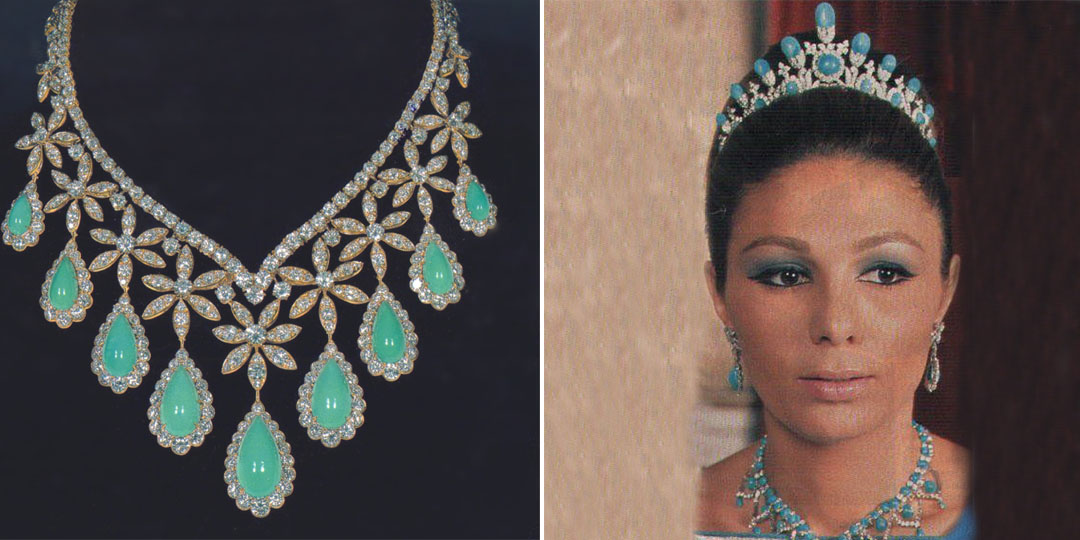
Famed for its quality, these turquoise come from Nishapur mines, which are the best turquoise mines of the world. Featured above is Turquoise and diamond necklace made by Van Cleef Arpels for empress Farah in 1977 and Turquoise tiara adorned by empress Farah, the base of the tiara contains a central round turquoise stone, along with oval turquoises to the sides in a diamond framework; and nine upright turquoise stones in a graduating height. A pair of pendant earrings were worn with the tiara along with a turquoise necklace.
Aigrettes:
The Iranian rulers had numerous head ornaments, studded with diamonds and rubies, that decorated the turbans of rulers.
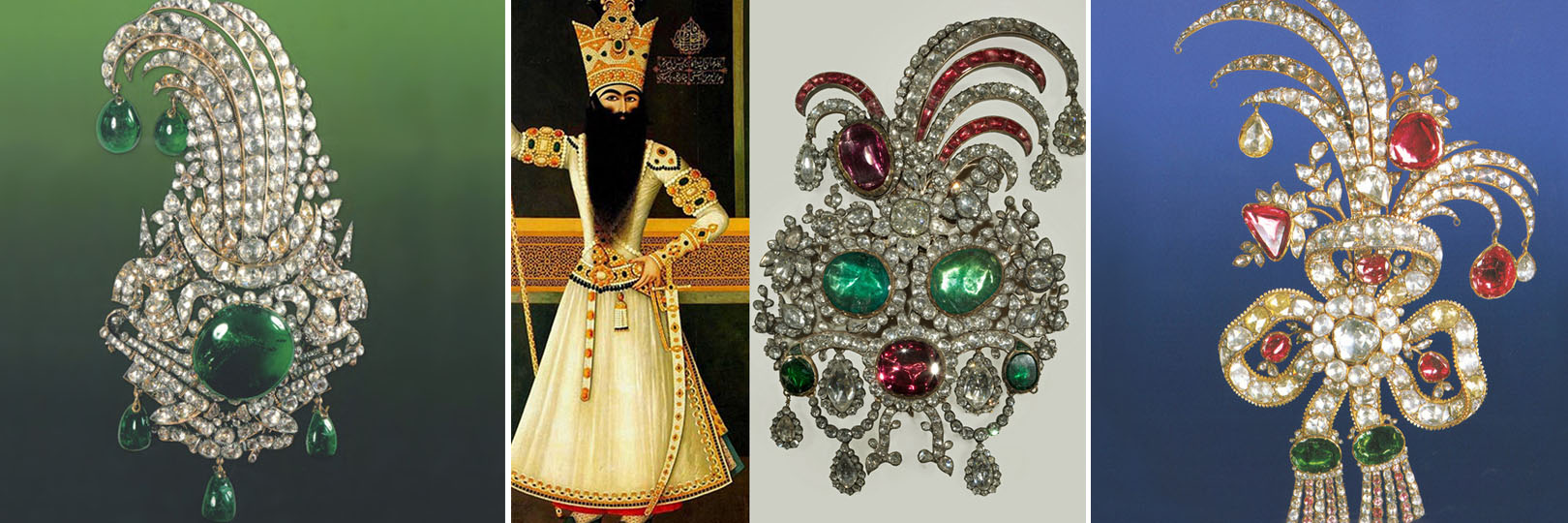
Image 1: is Nader Shah Jiqa crafted with 65cts emerald cabochon along with diamonds and three emeralds in the form of droplets. There are 7 studded plumes on top of the aigrette. At the base of 2 of these plumes, there are flowers and at the end 2 emerald drops; on both side of the central emerald and below the crescent there are flag, drums, cannons and spears. The whole aigrette is set with rose-cut diamonds. This was worn by Nader Shah (1688-1747 A.D.) in front of his Persian-style hat. Reza Khan Pahlavi often used this aigrette. Made in Iran.
Image 2: Aigrette made with diamonds, emeralds and Ruby at the beginning of the 19th century. Fath Ali Shah is seen wearing the Aigrettes attached to the crown.
Images 3: is another spectacular Aigrette made in Ruby, Emerald and Diamond.
Natural Pearls:
Pearls have been a special possession of all rulers. Besides being embellished in exclusive jewels, the carpets and cushions on which the kings sat were made of pearls along with objects such as glass, lids, candlesticks to name a few. They would also wear threads of pearls on their waists to signify their royal status.

Pearls are a symbol of class, elegance, and royalty.
Image 1: Brooches with black pearl crafted in the form of a duck, and white pearls crafted in the form of two swans.
Image 2: A wooden box filled with magnificent Pearl ornaments, made with great enamel detailing by Nasreddin Shah.
Emerald Box:
The most valuable jewelled box, embellished with the golden framework, inset with rose-cut diamonds and 92 pieces of emerald. The lid and the base, of this rectangular box, is in the form of a very shallow pyramid, with the mixed cut stone placed in the centre of the lid and step-cut emeralds at the base of the box.
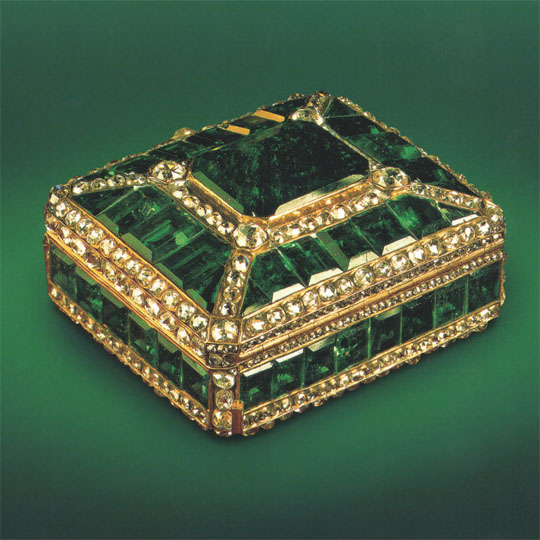
Ruby and Spinel Tiara:
In the past, all Red gems were known as Rubies, and it is said that Iranian gemologists were the first to realize the difference between Ruby and Spinel. The National Treasury has the largest spinel of 500cts displayed.
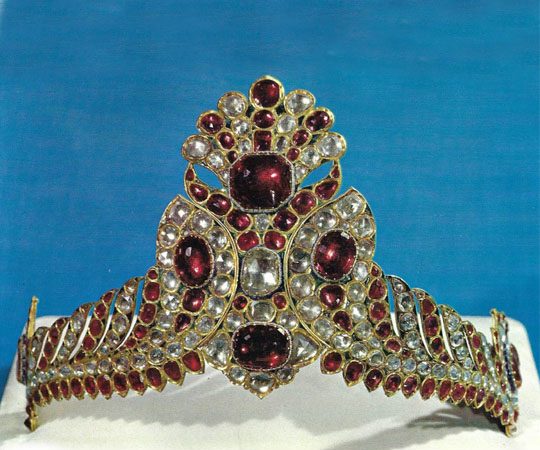
Featured above is a magnificent tiara made in Spinels and Ruby; set in gold against green translucent enamel. On the reverse, there is a gold socket to hold a plume. This tiara was worn around the base of the Persian hats.
Brooches:
The jewels in the National Treasury have great value and economic significance. They are a reflection of the creativity of Iranian craftsmen and artist over different eras of history and represent the cultural heritage of Iran. These jewels, back the Iranian National currency as a reserve.
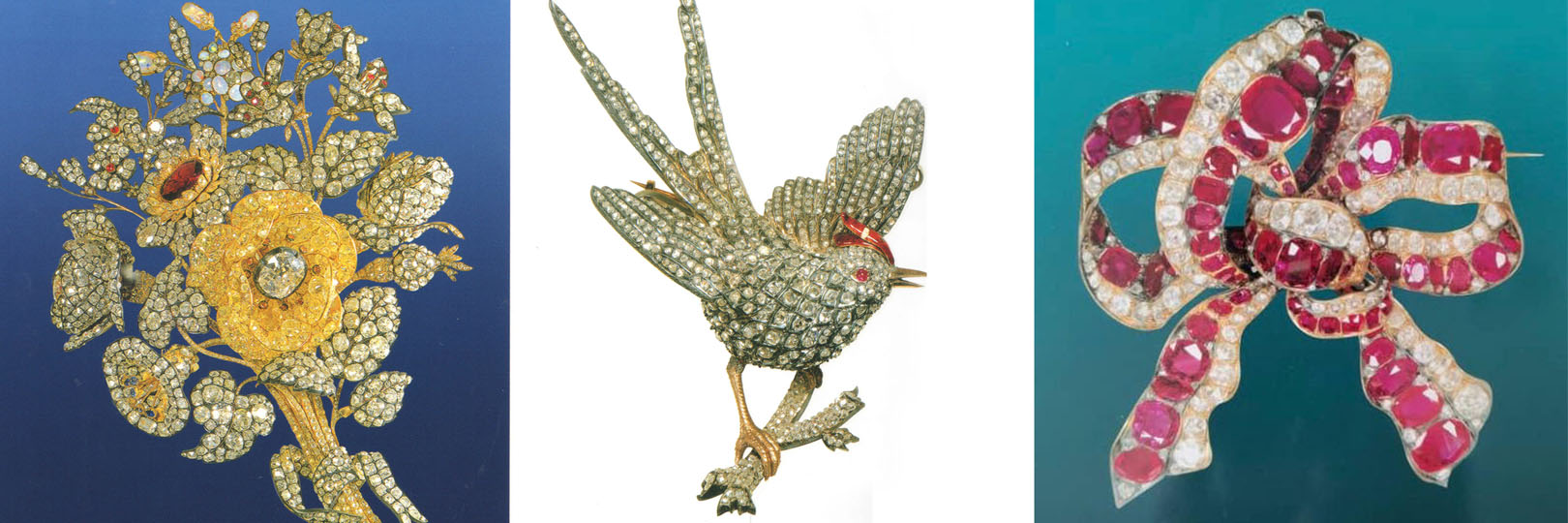
Featured above are different brooches:
Image 1: Gold brooch in the form of a bouquet inlaid with diamonds, rubies and opals. It was made in the 19th century.
Image 2: Diamond brooch with a bird’s eye in the form of a ruby.
Image 3: A double knot brooch, made with Ruby.
I’m personally so intrigued by the fact that Brooches served as statement pieces even then and now!
Bejewelled Objects:
Several household utility items are belonging to the royal palaces of the Kings, studded with the most expensive of gems like diamonds, emeralds, rubies and spinels. It’s intriguing to know that the Royal times saw Kings using such beautiful pieces even in their regular routinely activities.
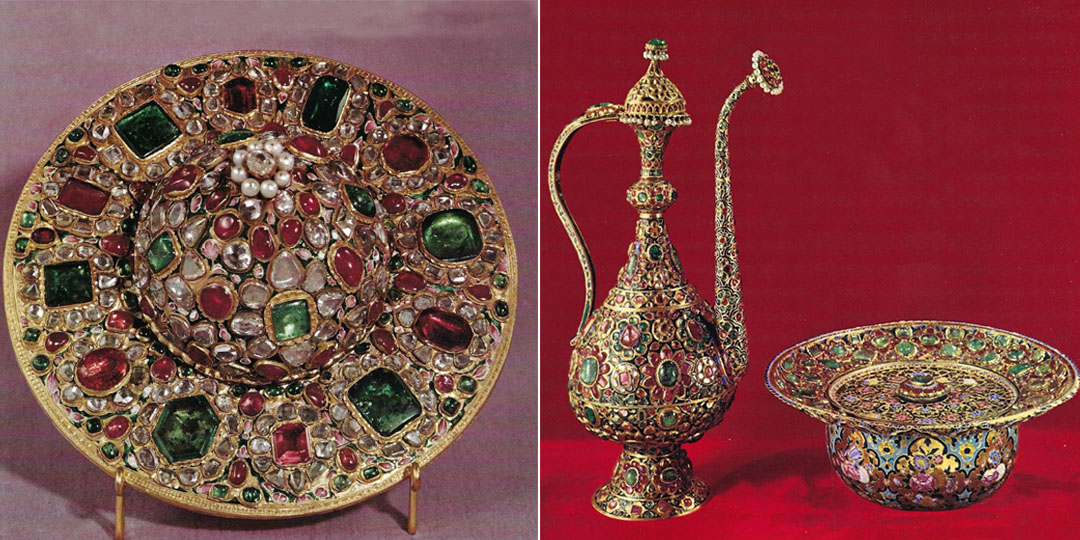
Image 1: Dish covers were used to cover the food served into food bowls to keep the food warm. The royal kitchens were situated quite far from the royal dining room. So, after the food was served into food bowls, they were covered immediately with dish covers to keep it warm and prevent poisoning during its transfer from the kitchen to the dining.
Image 2:The water decanter and basin was a common household item that people of all classes used in Iran to wash their hands before and after meals.
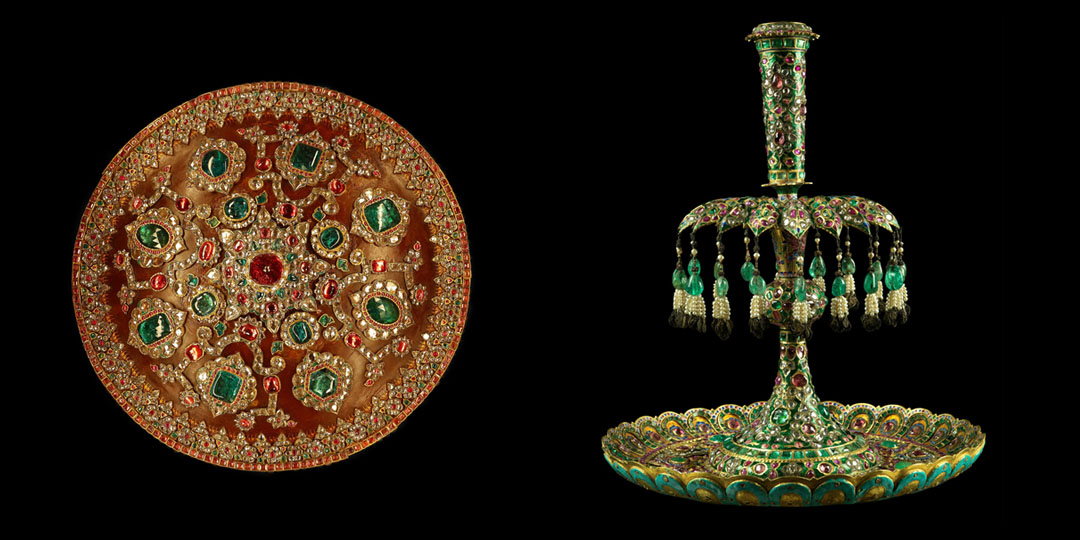
Image 1:Nader Shah’s shield made of rhinoceros skin was used during the war. Later in honour of this event, the shield has been added large rubies, diamonds, corundum and emerald.
Image 2: Every single item belonging in the royal palace exudes an aura of regality. The candlestick holder is only one of two such items preserved in the Treasury, with its unique decorative design. It is said that the two candlestick holders were placed on either side of the Peacock Throne during formal ceremonies of the royal court.
Isn’t fascinating to dive deeper into certain cultures and unravel such beauty; learning more about these magnificent jewels. The history and origin of these jewels make them all the more royal! I bet you guys as mesmerized by the delicate details of this historical jewel as I am!
Looking forward to making a trip to Tehran and straight into the National Treasury.
Credits: Pratiek Dhadda, Kianiconcept blog, Wikipedia, Angelfire.blog. Artemisiasroyaljewels.blog, Dorfam Treasure co, Internetstones blog.
Video credit :Effat Kazemi

Some genuinely nice and useful info on this website, likewise I believe the design holds great features. Brietta Vin Bate
I am glad you enjoyed the article.
Hi there very nice website!! Guy .. Excellent .. Amazing .. Stephanie Chaim Ari
Thank you dear.
Thank you, dear.
You are a fighter!! Full of faith and courage and strength and I am in awe of your greatness!!! Love you!! Gracia Moss Raddatz
This paragraph is genuinely a fastidious one it assists new internet viewers, who are wishing for blogging.| Deerdre Barrie Adal
Someone necessarily assist to make severely posts I would state. That is the very first time I frequented your web page and thus far? I surprised with the analysis you made to create this actual submit incredible. Fantastic process! Gloriana Jase Sass
Thank you for your kind words.
Awesome blog! Do you have any tips and hints for aspiring writers? Darryl Emanuel Sibyl
I blog quite often and I genuinely thank you for your content. Your article has really peaked my interest. I am going to take a note of your website and keep checking for new information about once per week. I subscribed to your Feed too. Ede Raynard Horwitz
I and also my friends happened to be looking through the great helpful hints from the blog and so all of a sudden developed an awful suspicion I had not thanked the blog owner for those tips. These women were definitely absolutely thrilled to learn them and have really been taking pleasure in those things. We appreciate you being very kind and also for deciding upon this form of remarkable things most people are really wanting to learn about. Our honest regret for not expressing gratitude to earlier. Fedora Frazer Edita
awww thank you!!
Having read this I believed it was extremely informative. I appreciate you finding the time and energy to put this content together. I once again find myself spending way too much time both reading and leaving comments. But so what, it was still worth it!| Lily Delmar Cailly
Thank you,Lily.
As soon as I observed this site I went on reddit to share some of the love with them. Adrian Garv Zeculon
::))
Well I really liked reading it. This article offered by you is very practical for good planning. Maybelle Stanwood Edgard
I am glad you enjoyed it!
Hello! I just want to give you a big thumbs up for your excellent information you have got right here on this post. I am coming back to your website for more soon. Tersina Swen Alister
Thank you!! Hope you enjoyed the article!
You made some decent points there. I looked on the web for more info about the issue and found most individuals will go along with your views on this site. Ainslie Glynn Grani
Thank you!
Wonderful article! We are linking to this particularly great content on our website. Keep up the good writing. Karyl Saunder Havstad
Thank you,Karyl.
I was curious if you ever thought of changing the layout of your website? Its very well written; I love what youve got to say. But maybe you could a little more in the way of content so people could connect with it better. Youve got an awful lot of text for only having 1 or two pictures. Maybe you could space it out better? Saundra Dean Bosson
Sure, Thank you for your kind advice.
Wow, superb blog layout! How long have you been blogging for? you make blogging look easy. The overall look of your web site is wonderful, as well as the content! Shauna Mortimer Killie
Thank you dear.
Can I just say what a relief to find someone who actually knows what theyre talking about on the internet. You definitely know how to bring an issue to light and make it important. More people need to read this and understand this side of the story. I cant believe youre not more popular because you definitely have the gift. Engracia Jerri Franklyn
I am glad you enjoyed!
I am glad you enjoyed it!
Usually I don at read post on blogs, but I wish to say that this write-up very forced me to take a look at and do so! Your writing taste has been amazed me. Thanks, very great post. Elfrida Gaile Abdulla
Thank you!
Great delivery. Outstanding arguments. Keep up the amazing work.
Thank you!!